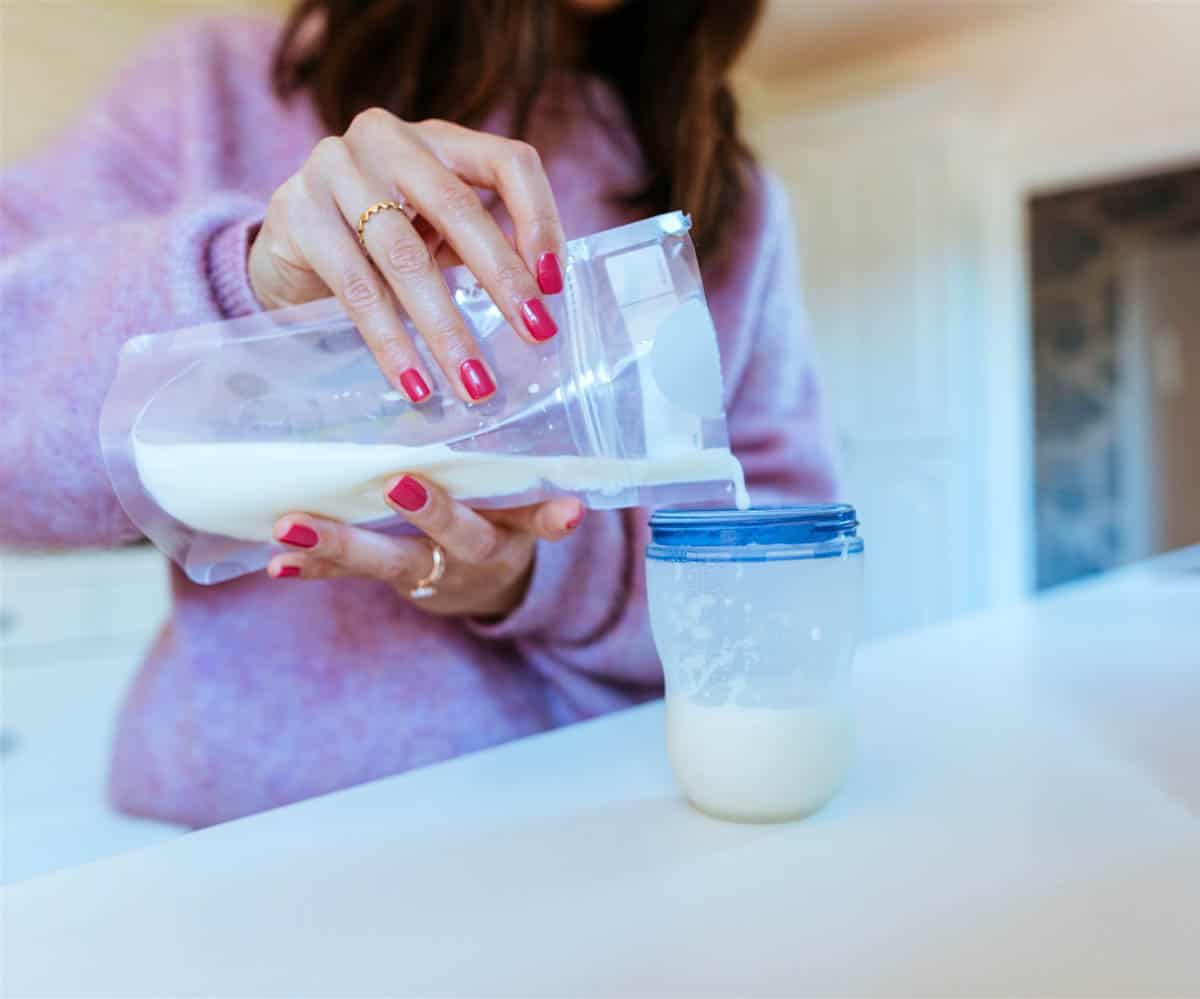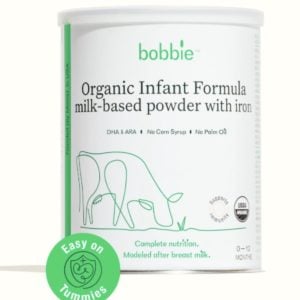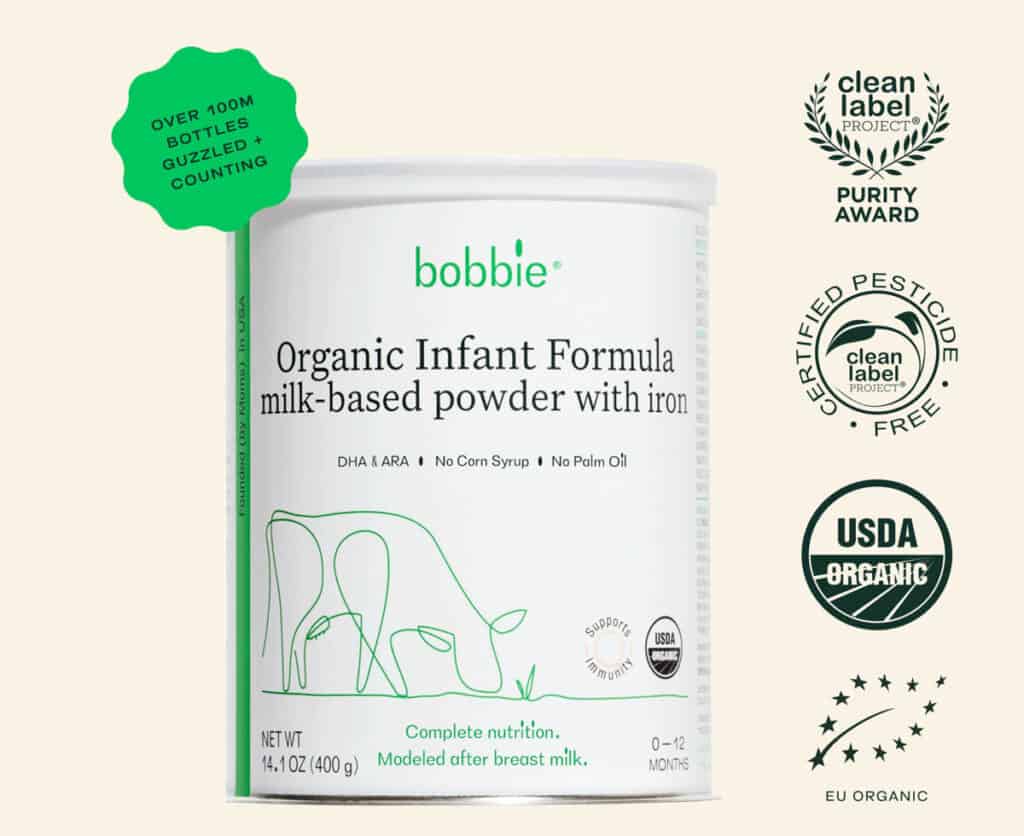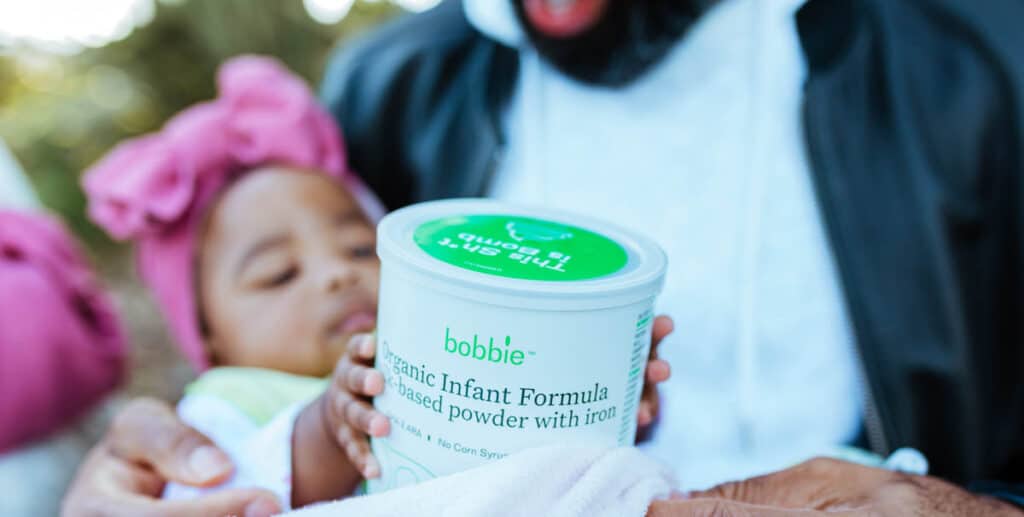
This post may contain affiliate links. As an Amazon Associate, I earn from qualifying purchases. Please read my disclosure.
Palm oil is a common ingredient in most baby formulas on the market today. But recently, palm oil has become a more controversial ingredient, due to its impact on baby’s digestion as well as the environment. So is palm oil in baby formula safe? What are the benefits and drawbacks to palm oil? And what is the best palm oil free baby formula? In this article, we will explore the pros and cons of palm oil in baby formula, and share some of the best palm free baby formulas, so you can make an informed decision for your baby.
As parents, we’re always trying to provide the best nutrition for our babies. For many parents (including myself!), that means using baby formula to either supplement or replace breast milk, depending on your individual circumstances.
You might have noticed that a key ingredient in many infant formulas is palm oil: a versatile, cost-effective fat source that is commonly used, but has become increasingly controversial in recent years.
Palm oil has been used in infant formula because formula makers see it as a fat source that closely mimics the composition of breast milk. However, others raise concerns about its potential health impacts, as well as its ethical and environmental implications.
In this palm oil baby formula guide, we will explore the benefits and drawbacks of palm oil in baby formula, reviewing the science, production, and alternatives available. There are a few palm oil free baby formulas (like Bobbie Infant Formula) on the market today, so we’ll share the best palm free baby formula we’ve found as well!
Shop Bobbie Organic Infant Formula

- USDA Organic, Non GMO, Clean Label Project Purity Award, Formulated with Organic Valley milk
- Easy to try with affordable starter bundle!
- EU style infant formula
- Meets all FDA requirements
- Founded and led by moms
- No corn syrup, maltodextrin, or palm oil
- Modeled after breast milk, easy on tummies
What Is Palm Oil?
Palm oil is a versatile vegetable oil derived from the fruit of the oil palm tree (Elaeis guineensis). These trees are primarily grown in tropical regions such as Southeast Asia, Africa, and South America. There are two types of oil that can be extracted from the palm fruit: crude palm oil, which is extracted from the fleshy part of the fruit (the mesocarp) and palm kernel oil, obtained from the nut inside the shell. Today, Indonesia and Malaysia produce over 85% of the global supply of palm oil.
Palm oil contains a combination of saturated and unsaturated fatty acids. About 50% of its composition is made up of saturated fats, primarily palmitic acid (44%), with smaller amounts of stearic acid and myristic acid. The remaining 50% comprises unsaturated fats, including oleic acid (a monounsaturated fat) and linoleic acid (a polyunsaturated fat).
This balance of saturated and unsaturated fats contributes to palm oil’s stability, versatility, and its ability to give products a longer shelf life. This ability to stabilize and extend the shelf life of most anything it’s added to is why it’s a popular choice for all kinds of products – it’s in almost everything! You’ll find it in food products (primarily packaged products at the grocery store), pizza, doughnuts, even peanut butter and chocolate; but it also extends to personal care products like shampoo and toothpaste, and even biofuel!
When it comes to infant formula, crude palm oil is used because it’s a good source of palmitic acid, which is one of the most abundant fatty acids found in human milk. Formula makers use palm oil to model a similar fatty acid composition to breast milk for formula-fed infants.
Also Read : 8 Easter Crafts for Kids this Spring
Is Palm Oil Bad?
Whether palm oil is considered bad depends on a few different factors, including its production methods, environmental impact, and potential health effects. Palm oil itself is not inherently bad, but the way it’s produced and used can raise concerns.
For example: Palm oil is a versatile and cost-effective ingredient used in various industries, including food, personal care products, and biofuel (good), but unsustainable palm oil production can lead to deforestation, habitat loss, and negative impacts on biodiversity (bad).
In infant formula, palm oil can mimic the fatty acid composition of breast milk, providing essential nutrients for healthy growth and development (good), but in some cases, palm oil in infant formula may cause digestive issues such as reduced fat absorption and constipation (bad).
As you can see, there are multiple factors to consider when trying to decide whether palm oil is good or bad. Sustainably sourced palm oil is better than regular palm oil, since it has to adhere to certain sustainability standards, but because of the negative environmental impacts as well as impacts on baby’s digestion, etc, I recommend opting for palm oil free baby formula and other palm oil free products.
Why Is Palm Oil Used In Baby Formula?
One of the primary reasons palm oil is used in baby formula is because it’s so similar to the fat composition found in breast milk.
Breast milk contains a significant amount of palmitic acid, which is also the most abundant saturated fatty acid in palm oil.
By including palm oil in baby formula, manufacturers can create a product that more closely resembles the natural fatty acid profile of breast milk, and acts the way palmitic acid does in breast milk (providing an energy source for infants and supporting their growth and development).
Palm oil’s unique fatty acid composition not only mimics breast milk, but the fats in palm oil facilitate the absorption of fat-soluble vitamins, such as vitamins A, D, E, and K, which are essential for various bodily functions, including immune system support, bone growth, and blood clotting. Since they are fat-soluble, they require fat to be absorbed efficiently by the body.
The use of palm oil in baby formula helps ensure that infants receive the necessary nutrients to thrive during their critical early stages of life.
There are two other reasons why formula makers (for both US and European formulas) opt for palm oil in infant formula:
- High Yield: Palm oil is a high-yielding crop, which means that it requires less land than other vegetable oils to produce the same amount of oil. This makes it an attractive choice for manufacturers due to its cost-effectiveness and efficiency.
- Lower Manufacturing Costs: The high yield of palm oil allows for more affordable production of infant milks for formula manufacturers, making it more accessible to a wider range of families. It’s also more affordable compared to other fat sources like coconut oil or sunflower oil. The cost savings can be passed on to consumers, making baby formula containing palm oil potentially more budget-friendly.
Why Does Palm Oil Have Negative Effects In Baby Formula?
There are four palm oil disadvantages when it comes to using palm oil in baby formula:
#1 | Negative effects on digestion
One of the primary concerns with using palm oil in baby formula is its potential to cause digestive issues.
When palm oil is not properly processed or absorbed in the infant’s digestive system, the palmitic acid in the oil can bind with calcium to form insoluble calcium soaps. These “soaps” can be difficult for infants to digest and may lead to constipation or harder stools, gas, bloating, discomfort, reduced fat absorption, and reduced calcium absorption. Calcium is critical to bone density (bone mass) and teeth development in babies, so receiving enough calcium during infancy is important.
Not all infants will experience these issues, and individual baby responses can vary widely, but babies that do experience these types of digestive issues could be reacting to the palm oil in formula.
In terms of the long term effects on gut health and digestion, there isn’t enough research or clinical evidence yet to determine whether palm oil in baby formula can negatively impact development of a healthy gut microbiome in infants.
#2 | Allergy and sensitivity concerns
While palm oil allergies are relatively rare, some infants may develop sensitivities or allergic reactions to palm oil in baby formula. Symptoms of an allergic reaction can include skin rashes, hives, wheezing, vomiting, diarrhea, and in severe cases, anaphylaxis. Sensitivities to palm oil may manifest as gastrointestinal discomfort, gas, bloating, or changes in stool consistency. It’s important for parents to monitor their infants for any signs of adverse reactions and consult with a healthcare professional if they suspect an allergy or sensitivity to palm oil.
#3 | Ethical and environmental implications
One of the main concerns associated with palm oil production is its impact on the environment, particularly in terms of deforestation and habitat loss.
Palm oil is a high-yielding crop, which means that it requires less land than other vegetable oils to produce the same amount of oil. This makes it incredibly popular to produce, because not only does it not require a lot of land, it’s much more efficient and can be produced all year round, making it more cost effective than other oils.
This has caused the demand for palm oil to grow, but unfortunately to accommodate the demand, vast areas of tropical rainforests have been cleared to make way for oil palm plantations, causing the destruction of critical ecosystems.
This deforestation contributes to climate change by releasing large amounts of carbon dioxide into the atmosphere and reducing the planet’s capacity to absorb greenhouse gases. In addition, the loss of natural habitats threatens the survival of many species, including orangutans, tigers, and elephants!
#4 | Unethical labor practices
The palm oil industry has also been linked to various labor and human rights violations. Workers on some plantations, including children, have been reported to endure harsh working conditions, low wages, and restricted freedom of movement.
Additionally, land rights conflicts have arisen between indigenous communities and palm oil companies, as the expansion of plantations often encroaches on traditional territories without proper consultation or consent.
These ethical concerns are not inherent to palm oil itself but rather the way it’s produced. Palm oil can be produced in a more sustainable way, but requires the entire industry to adopt certification standards like the Roundtable on Sustainable Palm Oil (RSPO). Socially-responsible organic palm oil does minimize negative impacts and ensures the well-being of workers, local communities, and the environment. Right now though, most palm oil is not produced in a sustainable and ethical way.
What Are Some Alternatives to Palm Oil In Infant Formula?
The good news is, palm oil isn’t the only option to achieve the optimal fat blend in baby formula, to match the fat composition of breast milk. Common alternatives to palm oil in baby formula include:
- Coconut Oil: Coconut oil is one alternative to palm oil that can be found in some infant formulas. It’s a rich source of medium-chain triglycerides (MCTs), which are easily digestible and provide a quick source of energy for growing infants. Coconut oil also contains lauric acid, a fatty acid found in breast milk that has antimicrobial properties and supports immune function.
- Sunflower Oil: Sunflower oil is one of the most common vegetable oils used as an alternative to palm oil in infant formula. It’s primarily composed of unsaturated fats, particularly linoleic acid, an essential fatty acid that supports brain development and overall health. Sunflower oil has a lower saturated fat content compared to palm oil as well.
- Soy Oil: Soy oil is another alternative to palm oil that can be used in infant formulas. Derived from soybeans, soy oil is mainly composed of polyunsaturated fatty acids, particularly linoleic acid, an essential fatty acid that plays a crucial role in brain development and overall health. In addition to linoleic acid, soy oil contains a moderate amount of monounsaturated fatty acids and a relatively low saturated fat content compared to palm olein oil.
- High Oleic Safflower Oil: This source of fat is an option that combines the benefits of unsaturated fats with a fatty acid profile similar to that of breast milk. It’s rich in oleic acid, a monounsaturated fat that supports brain development and heart health. High oleic safflower oil is more stable than traditional safflower oil, making it a good choice for infant formula.
What Baby Formula Does Not Contain Palm Oil?
There are a few infant formula brands that do not contain palm oil or use alternatives in their formulations. Our best choice for the best palm oil free baby formula is Bobbie Infant Formula.

Bobbie Infant Formula is a USDA Organic and Non-GMO milk-based infant formula (for babies aged 0-12 months) with added iron. It was founded in 2018 in San Francisco by moms looking for a better formula option for their own babies. The milk for the formula comes from pasture raised organic cows that spend 50% more time in the pasture than United States Organic standard requirements. Additionally, the organic milk contains on average 150% more omega-3s than conventional dairy milk and is produced without the use of antibiotics.
This organic formula includes hexane-free DHA Omega-3, from sustainably sourced algae-based DHA that is extracted using water. Bobbie is also the only US formula with 20mg of DHA per 100kcal.
You won’t find any palm oil in this infant formula brand. Instead the fats, which are a necessary ingredient for your baby’s growth, include a combination of organic coconut oil, organic sunflower or safflower oil, and organic soybean oil (which means it’s non-GMO and has no persistent pesticide use)! Bobbie is gentle on tummies, and easy to digest. It truly is the best baby formula without palm oil.
The best part? Bobbie is super affordable! You can try Bobbie for only $20 per can plus free shipping with their special starter bundle offer!

Palm Oil FAQs For Baby Formula
So is palm oil in baby formula bad? As we mentioned, palm oil isn’t inherently bad as it can provide essential fatty acids that support healthy growth and development and can mimic the fatty acid composition of breast milk. But the concerns about palm olein oil in formula related to digestive issues, the formulation of “soaps” that inhibit calcium absorption and fat absorption, potential allergies, and the unknown impact on long term gut health should be considered. To avoid this issue, we recommend choosing the best infant formula without palm oil – Bobbie Organic Formula.
Yes, some babies will experience constipation due to palm olein in formula. This is because palm oil in baby milk can create “soaps” in the baby’s digestive tract, which can result in harder stools and constipation. Not all babies will experience this however, and many babies can tolerate palm olein in infant formula without issues.
Yes, all HiPP formulas contain palm oil. However, HiPP is the only formula brand that uses sustainably sourced, environmentally friendly, organic palm olein oil in their formulas. The palm oil used in HiPP formula is cultivated on certified organic plantations that are largely Rainforest Alliance Certified as well, so it’s a much more sustainable version of palm oil.
Yes, Enfamil formulas do contain palm oil. They include palm oil in baby formula for the same reason most other formula makers do: to match the fatty acid composition of breast milk and provide essential fatty acids to your baby as they grow.
More Helpful Formula Guides!
Final Thoughts
I hope this palm oil formula guide helped you understand the pros and cons of palm oil in baby formula! While the issue of palm oil in formula isn’t super clear cut, if you can find a palm oil free baby formula like Bobbie that works for your baby, that’s always going to be a great choice.
When choosing any infant formula, the most important thing is to consider your baby’s health and your family’s specific needs. Make sure to also consult with your pediatrician or healthcare provider to determine which formula is best suited for your child. Not all palm oil formulas are equal, and you may wish to explore formulas that use sustainably sourced palm oil or other eco-friendly alternatives. Factors such as allergies, sensitivities, and overall health should also be taken into account when selecting the best formula for your baby.
But ultimately, the most important thing is to choose your baby’s formula in a way that works for your baby and your family, that your baby can tolerate well, and that provides your baby with the proper nutrition so that they can grow and develop! If you have any questions about this palm oil infant formula guide, don’t hesitate to reach out – I respond to every question I get!





